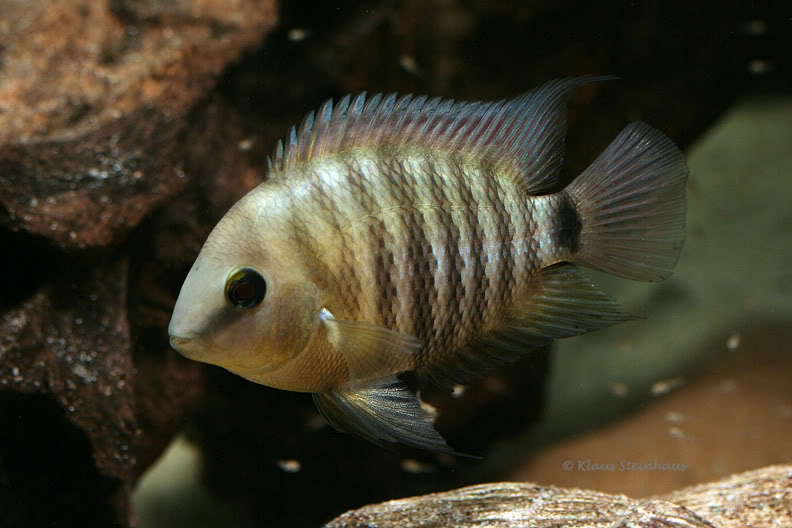
The Archocentrus spilurus “Cutteri” (Blue-eyed Cichlid) fry were approximately one-half inch long from tip of mouth to the base of their tail, at our monthly meeting in June when I first obtained them. Now here it is just over the three month mark at the October fish show that our club holds each year, and the fish that were fry at the time are now juveniles that are at a size of just over 1.5-inch in length from the tip of their mouths to the base of their tails. The largest of the six is a male that has reached a size of just over 2-inches from the tip of his mouth to the base of his tail. How did I do this? Well, let me tell you what I did to make this possible.
First of all, I took the young fry and placed them in a bare bottomed 20-gallon tall tank. This tank has a sponge filter to provide filtration, a Hagen Thermal Compact 50-watt heater that maintains the water temperature regulated to a constant 86 degrees Fahrenheit. It shares a 48-inch strip light with another 20-gallon tall tank beside it. The light over the tank is left on each day for no more than 12 hours. I am sure you are wondering why I keep the tank heated to such a high temperature. Well, that is quite simple actually. By raising them in a higher water temp. I was able to speed up the metabolism, a process in which the body converts food into energy for growth and activeness. At this temperature I am guessing that the metabolism of the fish that were in my care had been sped up at least to twice as fast as what someone would consider the normal.
Secondly, I used high protein foods. This is one of the most important keys for raising baby fish to adulthood. The foods I fed to the fish I was raising for this contest were in no particular order, but given daily are as follows: red worms (bought from a local Gander Mountain store), high protein growth pellets (52% protein level), Spirulina flakes, and HBH meat lovers flakes. All of these foods were fed to these fish each day, but in variable order. Meaning, I did not feed the same foods at the same time each day.
Third, would be swimming area. I agree an area with the dimensions of 12 inches by 24 inches does not seem like much room. But, it was plenty for these fish. Even at the sizes that the fish are now they were still under the old aquarium advice of “one inch of fish per gallon”. That statement is usually referred to as a rule, but for most fish it should just be thought of as advice. In the tank, the only decorations or objects in the tank were the heater, filter, and two ordinary rocks you might see in your yard if you dug into the ground. This helped make it possible for four of the fish to hide from the larger two that have decided to form a pair bond. With luck I should see a spawn from these two shortly since they have been guarding an area of the tank very aggressively, even at this young of an age. Well Joe, you were somewhat right with your joke. You said they would probably be breeding by the time I turned them in for judging. Well, you were close. I turned them in for judging after they formed a pair bond, laughing hysterically!
The fourth and final key to my success was water changes. I spent the extra time and changed at least 25% of the tank volume every other day for the entire time these fish were in my care for the contest. Clean water is one of the most important aspects of raising fish. Just as humans need clean oxygen, fish need clean oxygenated water to breathe properly, and remain healthy when fed the correct foods. I read in many places that fish produce a chemical, which in time is slowly released into the aquarium’s water, which when enough is accumulated will stunt their growth. By changing the water you lower the amount of this chemical along with the waste products from the fish themselves, such as nitrates, and other harmful compounds.
You now have my recipe of sorts for successfully raising baby fish to adulthood. This article is my compilation of the notes I took, and the steps I took to achieve the growth rate that I helped produce from these fish. I hope readers of this find it helpful and somewhat informative, so that they may use what they have read to their advantage in the future.
Leave a Reply